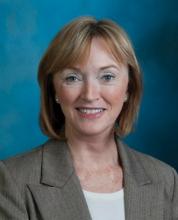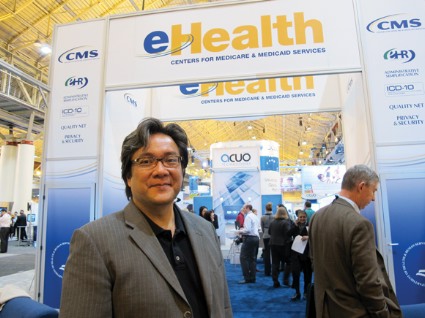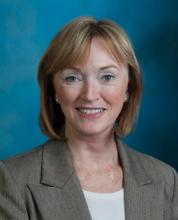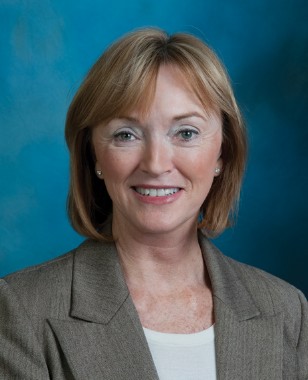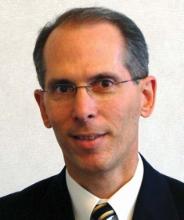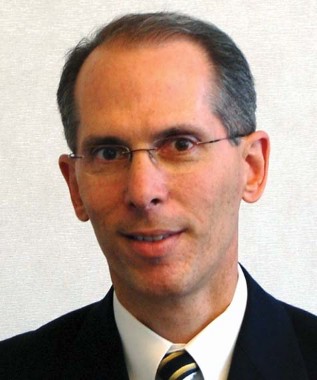User login
Healthcare Information and Management Systems Society (HIMSS): Annual Conference and Exhibition
CMS's eHealth initiative takes aim at runaway digital demands
NEW ORLEANS – The continuing onslaught of digital demands is overwhelming many practices’ ability to keep up, driving efficiency down and costs up. The Centers for Medicare and Medicaid Services wants to show that it feels physicians’ pain, and has launched what it calls its "eHealth" initiative to better coordinate and streamline the requests that come out of its offices.
The agency unveiled the initiative at the Healthcare Information and Management Systems Society Annual Conference and exhibition here, with officials telling attendees in multiple sessions – and with an exhibit hall booth and full-page ad in the daily meeting newspaper – how they plan to start paring down demands.
The initiative is the result of at least 18 months of strategizing within the Department of Health and Human Services (HHS) and represents just the beginning of a transformation, Robert Tagalicod, director of the CMS’s Office of E-Health Standards and Services, said in an interview.
HHS officials wanted to curb what they acknowledge is a huge – and growing – regulatory burden for physicians and other health care providers in the information technology area. Much of the focus was on how to better align rules and policies that come out of the CMS with those issued by the Office of the National Coordinator (ONC), which is located within the Office of the Secretary of HHS.
Among other things, the CMS set up a dedicated website for the initiative, www.cms.gov/eHealth, and a listserv that will "act as a central hub of information on implementation, guidance, milestones, and critical steps so that providers and other stakeholders have a single source of information on coordinating efforts toward implementing ICD-10, EHRs and meaningful use, operating standards, electronic quality measurement, and payment models," according to a blog post by Mr. Tagalicod.
The initiative aims to get more physicians using ICD-10, with which they must comply by Oct. 14, 2014. Although the move to that new coding system has been delayed several times, it will not be again, according to CMS Acting Administrator Marilyn Tavenner. "ICD-10 will go forward as designed," Ms. Tavenner told HIMSS13 attendees.
To make it easier for clinicians, the CMS and the ONC are talking about making use of ICD-10 eligible for an incentive payment under stage 3 of the meaningful use program, said Mr. Tagalicod.
In the quality arena, the CMS is going to align measurements with the six core areas set out by the National Quality Strategy. Wherever possible, quality measures will be made similar across CMS programs, said Dr. Kate Goodrich, acting director of the quality measurement and health assessment group at CMS’s Center for Clinical Standards and Quality.
For physicians, that means aligning the measures in the Physician Quality Reporting System with those required for meaningful use, for the Physician Value Modifier (PVM), and for the Medicare Shared Savings Program, said Dr. Goodrich. "The goal is report once – that’s become our mantra," she said. Physicians would report once and get credit for all the programs.
Ms. Tavenner told attendees the agency understands that, over the years, the quality of care programs had become "not easy to understand and even more difficult to implement." Now, the agency has "tried to reduce measures, align measures across programs, and become more focused on outcomes, less on process," she said, adding, "We want your feedback on that."
The eHealth initiative is also working with the National Quality Forum on a task force that aims to come up with a core set of measures that can be used across all payers, not just federal payers.
Part of the eHealth rollout included a "request for information" from health information technology companies on how to accelerate the exchange of data. "Our focus has to be on interoperability this year and we need your help in understanding what is working and where we are going to need to put additional resources," Ms. Tavenner said.
The CMS and other health agencies also are looking ahead to the future, Mr. Tagalicod said – what might happen 10 years down the road in a very quickly developing area. Among the developments the agency is monitoring: mobile health, data exchange in real time, and predictive health.
In the meantime, a big focus will be on "outreach, education, and training to providers" to help them "adopt a whole slew of eHealth," he noted.
"We want to get all the stakeholders together and say: How can we make this all better in a way that we plan it with clear goals, with clear milestones, and with clear roles and responsibilities?" he said.
NEW ORLEANS – The continuing onslaught of digital demands is overwhelming many practices’ ability to keep up, driving efficiency down and costs up. The Centers for Medicare and Medicaid Services wants to show that it feels physicians’ pain, and has launched what it calls its "eHealth" initiative to better coordinate and streamline the requests that come out of its offices.
The agency unveiled the initiative at the Healthcare Information and Management Systems Society Annual Conference and exhibition here, with officials telling attendees in multiple sessions – and with an exhibit hall booth and full-page ad in the daily meeting newspaper – how they plan to start paring down demands.
The initiative is the result of at least 18 months of strategizing within the Department of Health and Human Services (HHS) and represents just the beginning of a transformation, Robert Tagalicod, director of the CMS’s Office of E-Health Standards and Services, said in an interview.
HHS officials wanted to curb what they acknowledge is a huge – and growing – regulatory burden for physicians and other health care providers in the information technology area. Much of the focus was on how to better align rules and policies that come out of the CMS with those issued by the Office of the National Coordinator (ONC), which is located within the Office of the Secretary of HHS.
Among other things, the CMS set up a dedicated website for the initiative, www.cms.gov/eHealth, and a listserv that will "act as a central hub of information on implementation, guidance, milestones, and critical steps so that providers and other stakeholders have a single source of information on coordinating efforts toward implementing ICD-10, EHRs and meaningful use, operating standards, electronic quality measurement, and payment models," according to a blog post by Mr. Tagalicod.
The initiative aims to get more physicians using ICD-10, with which they must comply by Oct. 14, 2014. Although the move to that new coding system has been delayed several times, it will not be again, according to CMS Acting Administrator Marilyn Tavenner. "ICD-10 will go forward as designed," Ms. Tavenner told HIMSS13 attendees.
To make it easier for clinicians, the CMS and the ONC are talking about making use of ICD-10 eligible for an incentive payment under stage 3 of the meaningful use program, said Mr. Tagalicod.
In the quality arena, the CMS is going to align measurements with the six core areas set out by the National Quality Strategy. Wherever possible, quality measures will be made similar across CMS programs, said Dr. Kate Goodrich, acting director of the quality measurement and health assessment group at CMS’s Center for Clinical Standards and Quality.
For physicians, that means aligning the measures in the Physician Quality Reporting System with those required for meaningful use, for the Physician Value Modifier (PVM), and for the Medicare Shared Savings Program, said Dr. Goodrich. "The goal is report once – that’s become our mantra," she said. Physicians would report once and get credit for all the programs.
Ms. Tavenner told attendees the agency understands that, over the years, the quality of care programs had become "not easy to understand and even more difficult to implement." Now, the agency has "tried to reduce measures, align measures across programs, and become more focused on outcomes, less on process," she said, adding, "We want your feedback on that."
The eHealth initiative is also working with the National Quality Forum on a task force that aims to come up with a core set of measures that can be used across all payers, not just federal payers.
Part of the eHealth rollout included a "request for information" from health information technology companies on how to accelerate the exchange of data. "Our focus has to be on interoperability this year and we need your help in understanding what is working and where we are going to need to put additional resources," Ms. Tavenner said.
The CMS and other health agencies also are looking ahead to the future, Mr. Tagalicod said – what might happen 10 years down the road in a very quickly developing area. Among the developments the agency is monitoring: mobile health, data exchange in real time, and predictive health.
In the meantime, a big focus will be on "outreach, education, and training to providers" to help them "adopt a whole slew of eHealth," he noted.
"We want to get all the stakeholders together and say: How can we make this all better in a way that we plan it with clear goals, with clear milestones, and with clear roles and responsibilities?" he said.
NEW ORLEANS – The continuing onslaught of digital demands is overwhelming many practices’ ability to keep up, driving efficiency down and costs up. The Centers for Medicare and Medicaid Services wants to show that it feels physicians’ pain, and has launched what it calls its "eHealth" initiative to better coordinate and streamline the requests that come out of its offices.
The agency unveiled the initiative at the Healthcare Information and Management Systems Society Annual Conference and exhibition here, with officials telling attendees in multiple sessions – and with an exhibit hall booth and full-page ad in the daily meeting newspaper – how they plan to start paring down demands.
The initiative is the result of at least 18 months of strategizing within the Department of Health and Human Services (HHS) and represents just the beginning of a transformation, Robert Tagalicod, director of the CMS’s Office of E-Health Standards and Services, said in an interview.
HHS officials wanted to curb what they acknowledge is a huge – and growing – regulatory burden for physicians and other health care providers in the information technology area. Much of the focus was on how to better align rules and policies that come out of the CMS with those issued by the Office of the National Coordinator (ONC), which is located within the Office of the Secretary of HHS.
Among other things, the CMS set up a dedicated website for the initiative, www.cms.gov/eHealth, and a listserv that will "act as a central hub of information on implementation, guidance, milestones, and critical steps so that providers and other stakeholders have a single source of information on coordinating efforts toward implementing ICD-10, EHRs and meaningful use, operating standards, electronic quality measurement, and payment models," according to a blog post by Mr. Tagalicod.
The initiative aims to get more physicians using ICD-10, with which they must comply by Oct. 14, 2014. Although the move to that new coding system has been delayed several times, it will not be again, according to CMS Acting Administrator Marilyn Tavenner. "ICD-10 will go forward as designed," Ms. Tavenner told HIMSS13 attendees.
To make it easier for clinicians, the CMS and the ONC are talking about making use of ICD-10 eligible for an incentive payment under stage 3 of the meaningful use program, said Mr. Tagalicod.
In the quality arena, the CMS is going to align measurements with the six core areas set out by the National Quality Strategy. Wherever possible, quality measures will be made similar across CMS programs, said Dr. Kate Goodrich, acting director of the quality measurement and health assessment group at CMS’s Center for Clinical Standards and Quality.
For physicians, that means aligning the measures in the Physician Quality Reporting System with those required for meaningful use, for the Physician Value Modifier (PVM), and for the Medicare Shared Savings Program, said Dr. Goodrich. "The goal is report once – that’s become our mantra," she said. Physicians would report once and get credit for all the programs.
Ms. Tavenner told attendees the agency understands that, over the years, the quality of care programs had become "not easy to understand and even more difficult to implement." Now, the agency has "tried to reduce measures, align measures across programs, and become more focused on outcomes, less on process," she said, adding, "We want your feedback on that."
The eHealth initiative is also working with the National Quality Forum on a task force that aims to come up with a core set of measures that can be used across all payers, not just federal payers.
Part of the eHealth rollout included a "request for information" from health information technology companies on how to accelerate the exchange of data. "Our focus has to be on interoperability this year and we need your help in understanding what is working and where we are going to need to put additional resources," Ms. Tavenner said.
The CMS and other health agencies also are looking ahead to the future, Mr. Tagalicod said – what might happen 10 years down the road in a very quickly developing area. Among the developments the agency is monitoring: mobile health, data exchange in real time, and predictive health.
In the meantime, a big focus will be on "outreach, education, and training to providers" to help them "adopt a whole slew of eHealth," he noted.
"We want to get all the stakeholders together and say: How can we make this all better in a way that we plan it with clear goals, with clear milestones, and with clear roles and responsibilities?" he said.
AT THE HIMSS13 ANNUAL MEETING
CMS sets aggressive 2013 meaningful use targets
NEW ORLEANS – The Centers for Medicare and Medicaid Services is expecting half of eligible physician offices and 80% of eligible hospitals to be meaningful users of electronic health records this year – a target that even the agency itself calls aggressive.
To date, 161,890 eligible professionals – out of 527,200 who are eligible – have attested to meaningful use, according to the most recent statistics from CMS. Most of those (161,677) did so successfully. About 200 were not successful. Of the 5,011 hospitals that are eligible, 2,653 have been successful. None failed.
So far, all of the eligible professionals and hospitals have had to prove only that they are meaningful users under stage 1 of the program. The rules outlining stage 2 criteria were published last year. The earliest physicians would have to attest to stage 2 criteria would be in 2014.
Even so, "2013 is going to be a busy year," said CMS Acting Administrator Marilyn Tavenner at the Healthcare Information and Management Systems Society annual conference. But the agency will try to take some heat off physicians and hospitals struggling to work within stage 1 and ramping up for stage 2, she said.
"We are going to spend 2013 focusing on education, focusing on learning, and focusing on what is working in stage 2 and what is not working in stage 2," said Ms. Tavenner.
She added that doctors would get a special focus this year. "We’re going to spend a lot more time with physicians – helping physicians learn, and helping physicians work with their current vendors to make things a little easier for them," Ms. Tavenner promised.
Under stage 2, physicians will have to meet a total of 20 core objectives. Among the new objectives: demonstrating the ability to use secure electronic messaging to communicate with patients; and providing patients the ability to view online, download, and transmit their health information within 4 days of those data being available to the doctor.
CMS still aims to have physicians begin attesting to stage 3 in 2016. However, the agency will hold off on issuing any stage 3 regulations for now, she said. "We are not going to issue additional rules in 2013," Ms. Tavenner said. "We are going to learn from stage 2 so it can help us design where we are going in stage 3."
Part of that learning curve will include what Ms. Tavenner called "tiny" audits. The idea is that CMS would work collaboratively with physicians and hospitals to figure out how to begin to audit electronic health records.
"This is a give and take – this is not like a payment audit," she explained. The goal is to understand what happens once a system is installed – that is, are physicians using it regularly and getting any benefit – and to determine what changes CMS might need to make, said Ms. Tavenner.
The agency will also convene a summit with physicians, hospitals, systems vendors, and government officials in May, she said. Again, the focus will be on understanding what needs to happen in stage 2.
On Twitter @aliciaault
NEW ORLEANS – The Centers for Medicare and Medicaid Services is expecting half of eligible physician offices and 80% of eligible hospitals to be meaningful users of electronic health records this year – a target that even the agency itself calls aggressive.
To date, 161,890 eligible professionals – out of 527,200 who are eligible – have attested to meaningful use, according to the most recent statistics from CMS. Most of those (161,677) did so successfully. About 200 were not successful. Of the 5,011 hospitals that are eligible, 2,653 have been successful. None failed.
So far, all of the eligible professionals and hospitals have had to prove only that they are meaningful users under stage 1 of the program. The rules outlining stage 2 criteria were published last year. The earliest physicians would have to attest to stage 2 criteria would be in 2014.
Even so, "2013 is going to be a busy year," said CMS Acting Administrator Marilyn Tavenner at the Healthcare Information and Management Systems Society annual conference. But the agency will try to take some heat off physicians and hospitals struggling to work within stage 1 and ramping up for stage 2, she said.
"We are going to spend 2013 focusing on education, focusing on learning, and focusing on what is working in stage 2 and what is not working in stage 2," said Ms. Tavenner.
She added that doctors would get a special focus this year. "We’re going to spend a lot more time with physicians – helping physicians learn, and helping physicians work with their current vendors to make things a little easier for them," Ms. Tavenner promised.
Under stage 2, physicians will have to meet a total of 20 core objectives. Among the new objectives: demonstrating the ability to use secure electronic messaging to communicate with patients; and providing patients the ability to view online, download, and transmit their health information within 4 days of those data being available to the doctor.
CMS still aims to have physicians begin attesting to stage 3 in 2016. However, the agency will hold off on issuing any stage 3 regulations for now, she said. "We are not going to issue additional rules in 2013," Ms. Tavenner said. "We are going to learn from stage 2 so it can help us design where we are going in stage 3."
Part of that learning curve will include what Ms. Tavenner called "tiny" audits. The idea is that CMS would work collaboratively with physicians and hospitals to figure out how to begin to audit electronic health records.
"This is a give and take – this is not like a payment audit," she explained. The goal is to understand what happens once a system is installed – that is, are physicians using it regularly and getting any benefit – and to determine what changes CMS might need to make, said Ms. Tavenner.
The agency will also convene a summit with physicians, hospitals, systems vendors, and government officials in May, she said. Again, the focus will be on understanding what needs to happen in stage 2.
On Twitter @aliciaault
NEW ORLEANS – The Centers for Medicare and Medicaid Services is expecting half of eligible physician offices and 80% of eligible hospitals to be meaningful users of electronic health records this year – a target that even the agency itself calls aggressive.
To date, 161,890 eligible professionals – out of 527,200 who are eligible – have attested to meaningful use, according to the most recent statistics from CMS. Most of those (161,677) did so successfully. About 200 were not successful. Of the 5,011 hospitals that are eligible, 2,653 have been successful. None failed.
So far, all of the eligible professionals and hospitals have had to prove only that they are meaningful users under stage 1 of the program. The rules outlining stage 2 criteria were published last year. The earliest physicians would have to attest to stage 2 criteria would be in 2014.
Even so, "2013 is going to be a busy year," said CMS Acting Administrator Marilyn Tavenner at the Healthcare Information and Management Systems Society annual conference. But the agency will try to take some heat off physicians and hospitals struggling to work within stage 1 and ramping up for stage 2, she said.
"We are going to spend 2013 focusing on education, focusing on learning, and focusing on what is working in stage 2 and what is not working in stage 2," said Ms. Tavenner.
She added that doctors would get a special focus this year. "We’re going to spend a lot more time with physicians – helping physicians learn, and helping physicians work with their current vendors to make things a little easier for them," Ms. Tavenner promised.
Under stage 2, physicians will have to meet a total of 20 core objectives. Among the new objectives: demonstrating the ability to use secure electronic messaging to communicate with patients; and providing patients the ability to view online, download, and transmit their health information within 4 days of those data being available to the doctor.
CMS still aims to have physicians begin attesting to stage 3 in 2016. However, the agency will hold off on issuing any stage 3 regulations for now, she said. "We are not going to issue additional rules in 2013," Ms. Tavenner said. "We are going to learn from stage 2 so it can help us design where we are going in stage 3."
Part of that learning curve will include what Ms. Tavenner called "tiny" audits. The idea is that CMS would work collaboratively with physicians and hospitals to figure out how to begin to audit electronic health records.
"This is a give and take – this is not like a payment audit," she explained. The goal is to understand what happens once a system is installed – that is, are physicians using it regularly and getting any benefit – and to determine what changes CMS might need to make, said Ms. Tavenner.
The agency will also convene a summit with physicians, hospitals, systems vendors, and government officials in May, she said. Again, the focus will be on understanding what needs to happen in stage 2.
On Twitter @aliciaault
AT THE HIMSS13 ANNUAL CONFERENCE
Survey exposes physician frustrations with EHRs
NEW ORLEANS – Frustrated with your electronic medical record system? Getting increasingly irritated? You most definitely are not alone.
A survey of thousands of physicians across multiple specialties shows that user satisfaction with electronic health records fell 12% from 2010 to 2012.
The survey was conducted by the American College of Physicians and AmericanEHR Partners, an online agent that helps physicians select and evaluate health information technology. It is supported by 16 medical societies and five health IT organizations.
"Dissatisfaction is increasing regardless of practice type or EHR system," said Dr. Michael S. Barr, who leads ACP\'s Medical Practice, Professionalism & Quality division. "These findings highlight the need for the Meaningful Use program and EHR manufacturers to focus on improving EHR features and usability to help reduce inefficient work flows, improve error rates and patient care, and for practices to recognize the importance of ongoing training at all stages of EHR adoption," said Dr. Barr, in a statement issued along with the survey results.
The survey was released at the Healthcare Information and Management Systems Society Annual Conference and exhibition.
Dr. Alan Brookstone, a cofounder of AmericanEHR Partners, said at the meeting that satisfaction rates may be dropping in part because there had been so much adoption of technology so quickly. Also, it’s not just the early adopters anymore, he said.
The largest number of respondents – almost 1,900 – was from primary care. Specialists, surgeons, hospital-based physicians, and psychiatrists were also represented.
The vast majority of respondents – 70% – were from practices with fewer than 10 physicians.
The number who said they intended to participate in meaningful use has grown over the past few years, with a full 82% saying they would apply for incentives paid by Medicare and Medicaid.
Satisfaction rates with current EHR systems were low across a spectrum of parameters. While 45% said they would recommend the product they use to a colleague, 39% said they would not. In 2010, more physicians said they’d recommend that system, while only 24% said they would urge against use.
Of those surveyed, 36% said that they had encountered unexpected events, problems, or costs after signing the initial contract for the system.
Physicians were especially frustrated with the systems’ promise to decrease their workload. Thirty-four percent said they were dissatisfied with that promised ability, up from only 19% in 2010. Some respondents said that the EHR had decreased productivity and increased the amount of time needed to complete documentation. Fully a third of respondents said they had not returned to the productivity they had before they began to use the system.
About half of respondents were satisfied with functionality and ease of use, but a third were dissatisfied with those measures. That level of dissatisfaction was higher than it had been in 2010.
For instance, thirty-six percent said that it was difficult to reconcile an imported medication list with medications listed in a patient record.
Overall, when compared with other specialties, primary care physicians were the most satisfied with their system’s ability to improve patient care. Surgeons, representing about 660 respondents, were the least satisfied.
Good customer support and training for the EHR systems was rated as crucial to satisfaction. There was an 11% increase in dissatisfaction with customer support from 2010 to 2012. Thirty-three percent of respondents said they weren’t happy with the customer support they received.
The number of practices using a patient portal increased by 20% from 2010 to 2012, rising to 40%. This is probably driven by the stage 2 meaningful use rules, which require physicians to be able to securely communicate with patients and for patients to be able to download and share their health information. Still, 50% of respondents did not have a portal.
Dr. Brookstone said they survey showed that vendors needed to better integrate functionality, improve training, and find ways to help physicians rebalance their workload.
If physicians’ concerns aren’t addressed, it will lead to a decline in willingness to use the systems, he said.
NEW ORLEANS – Frustrated with your electronic medical record system? Getting increasingly irritated? You most definitely are not alone.
A survey of thousands of physicians across multiple specialties shows that user satisfaction with electronic health records fell 12% from 2010 to 2012.
The survey was conducted by the American College of Physicians and AmericanEHR Partners, an online agent that helps physicians select and evaluate health information technology. It is supported by 16 medical societies and five health IT organizations.
"Dissatisfaction is increasing regardless of practice type or EHR system," said Dr. Michael S. Barr, who leads ACP\'s Medical Practice, Professionalism & Quality division. "These findings highlight the need for the Meaningful Use program and EHR manufacturers to focus on improving EHR features and usability to help reduce inefficient work flows, improve error rates and patient care, and for practices to recognize the importance of ongoing training at all stages of EHR adoption," said Dr. Barr, in a statement issued along with the survey results.
The survey was released at the Healthcare Information and Management Systems Society Annual Conference and exhibition.
Dr. Alan Brookstone, a cofounder of AmericanEHR Partners, said at the meeting that satisfaction rates may be dropping in part because there had been so much adoption of technology so quickly. Also, it’s not just the early adopters anymore, he said.
The largest number of respondents – almost 1,900 – was from primary care. Specialists, surgeons, hospital-based physicians, and psychiatrists were also represented.
The vast majority of respondents – 70% – were from practices with fewer than 10 physicians.
The number who said they intended to participate in meaningful use has grown over the past few years, with a full 82% saying they would apply for incentives paid by Medicare and Medicaid.
Satisfaction rates with current EHR systems were low across a spectrum of parameters. While 45% said they would recommend the product they use to a colleague, 39% said they would not. In 2010, more physicians said they’d recommend that system, while only 24% said they would urge against use.
Of those surveyed, 36% said that they had encountered unexpected events, problems, or costs after signing the initial contract for the system.
Physicians were especially frustrated with the systems’ promise to decrease their workload. Thirty-four percent said they were dissatisfied with that promised ability, up from only 19% in 2010. Some respondents said that the EHR had decreased productivity and increased the amount of time needed to complete documentation. Fully a third of respondents said they had not returned to the productivity they had before they began to use the system.
About half of respondents were satisfied with functionality and ease of use, but a third were dissatisfied with those measures. That level of dissatisfaction was higher than it had been in 2010.
For instance, thirty-six percent said that it was difficult to reconcile an imported medication list with medications listed in a patient record.
Overall, when compared with other specialties, primary care physicians were the most satisfied with their system’s ability to improve patient care. Surgeons, representing about 660 respondents, were the least satisfied.
Good customer support and training for the EHR systems was rated as crucial to satisfaction. There was an 11% increase in dissatisfaction with customer support from 2010 to 2012. Thirty-three percent of respondents said they weren’t happy with the customer support they received.
The number of practices using a patient portal increased by 20% from 2010 to 2012, rising to 40%. This is probably driven by the stage 2 meaningful use rules, which require physicians to be able to securely communicate with patients and for patients to be able to download and share their health information. Still, 50% of respondents did not have a portal.
Dr. Brookstone said they survey showed that vendors needed to better integrate functionality, improve training, and find ways to help physicians rebalance their workload.
If physicians’ concerns aren’t addressed, it will lead to a decline in willingness to use the systems, he said.
NEW ORLEANS – Frustrated with your electronic medical record system? Getting increasingly irritated? You most definitely are not alone.
A survey of thousands of physicians across multiple specialties shows that user satisfaction with electronic health records fell 12% from 2010 to 2012.
The survey was conducted by the American College of Physicians and AmericanEHR Partners, an online agent that helps physicians select and evaluate health information technology. It is supported by 16 medical societies and five health IT organizations.
"Dissatisfaction is increasing regardless of practice type or EHR system," said Dr. Michael S. Barr, who leads ACP\'s Medical Practice, Professionalism & Quality division. "These findings highlight the need for the Meaningful Use program and EHR manufacturers to focus on improving EHR features and usability to help reduce inefficient work flows, improve error rates and patient care, and for practices to recognize the importance of ongoing training at all stages of EHR adoption," said Dr. Barr, in a statement issued along with the survey results.
The survey was released at the Healthcare Information and Management Systems Society Annual Conference and exhibition.
Dr. Alan Brookstone, a cofounder of AmericanEHR Partners, said at the meeting that satisfaction rates may be dropping in part because there had been so much adoption of technology so quickly. Also, it’s not just the early adopters anymore, he said.
The largest number of respondents – almost 1,900 – was from primary care. Specialists, surgeons, hospital-based physicians, and psychiatrists were also represented.
The vast majority of respondents – 70% – were from practices with fewer than 10 physicians.
The number who said they intended to participate in meaningful use has grown over the past few years, with a full 82% saying they would apply for incentives paid by Medicare and Medicaid.
Satisfaction rates with current EHR systems were low across a spectrum of parameters. While 45% said they would recommend the product they use to a colleague, 39% said they would not. In 2010, more physicians said they’d recommend that system, while only 24% said they would urge against use.
Of those surveyed, 36% said that they had encountered unexpected events, problems, or costs after signing the initial contract for the system.
Physicians were especially frustrated with the systems’ promise to decrease their workload. Thirty-four percent said they were dissatisfied with that promised ability, up from only 19% in 2010. Some respondents said that the EHR had decreased productivity and increased the amount of time needed to complete documentation. Fully a third of respondents said they had not returned to the productivity they had before they began to use the system.
About half of respondents were satisfied with functionality and ease of use, but a third were dissatisfied with those measures. That level of dissatisfaction was higher than it had been in 2010.
For instance, thirty-six percent said that it was difficult to reconcile an imported medication list with medications listed in a patient record.
Overall, when compared with other specialties, primary care physicians were the most satisfied with their system’s ability to improve patient care. Surgeons, representing about 660 respondents, were the least satisfied.
Good customer support and training for the EHR systems was rated as crucial to satisfaction. There was an 11% increase in dissatisfaction with customer support from 2010 to 2012. Thirty-three percent of respondents said they weren’t happy with the customer support they received.
The number of practices using a patient portal increased by 20% from 2010 to 2012, rising to 40%. This is probably driven by the stage 2 meaningful use rules, which require physicians to be able to securely communicate with patients and for patients to be able to download and share their health information. Still, 50% of respondents did not have a portal.
Dr. Brookstone said they survey showed that vendors needed to better integrate functionality, improve training, and find ways to help physicians rebalance their workload.
If physicians’ concerns aren’t addressed, it will lead to a decline in willingness to use the systems, he said.
AT THE HIMSS13 ANNUAL CONFERENCE

